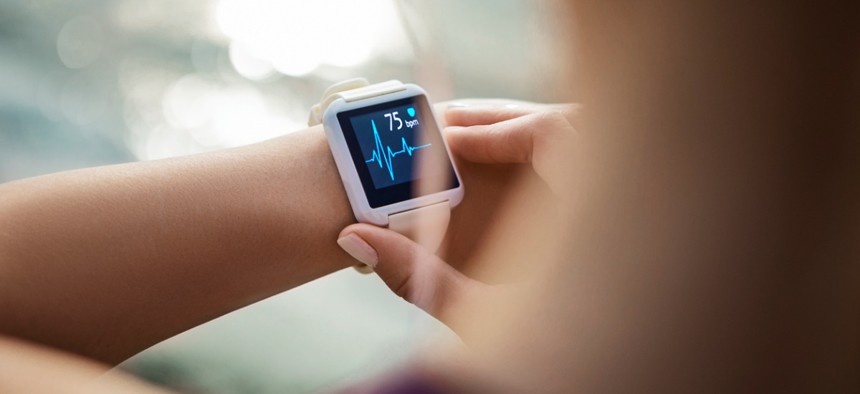DHS Wants Wearables to Track Employee Health at Work and at Home

Nastasic/istockphoto.com
The biometric tech will be used to help employees manage physical and mental health in high-stress mission areas.
The Homeland Security Department wants to build a tech solution to monitor the health and stress levels of its employees to help identify when workers need assistance—due to physical or mental weariness—and optimize “human performance and resiliency” among the workforce.
The department issued a call for proposals looking for solutions that incorporate biometric technologies to monitor employees’ health and “psychosocial information” entered into the software by the user. That data will be supported by algorithms that can alert employees to oncoming physical and mental health issues and suggest actions that can be taken to avert those breakdowns.
“The scope of this project is to find innovative technological solutions that will improve the overall health and wellness of those consistently placed in high-stress and dangerous conditions,” the call states. “DHS is seeking capabilities that not only promote intervention action when necessary, but preemptively and in real-time optimize DHS personnel performance and resilience.”
Those solutions should be able to address three goals:
- Increase self-awareness of physical and mental status and associated limitations.
- Promote actions or provide interventions that optimize human performance and resilience.
- Define how DHS can measure well-being as a trackable metric over time.
The effort is targeted specifically at the Customs and Border Protection workforce, though officials are looking for solutions that can be used across the department.
Officials note the DHS workforce often has particularly stressful jobs.
“Officer safety and wellness research has found that compared to other professionals, officers work under stressful conditions and are regularly exposed to the risk of accidents, physical attacks, or other trauma,” the call states. “To varying degrees, law enforcement officers are exposed to stressors such as radiation, chemical, biological and physical risks; and shift work, sleep disorders and other negative health sequelae.”
The call for proposals lists a number of factors that can pile on to these stressors, including “long hours, shift work, hot and cold environments,” as well as “negative perceptions of law enforcement, including scrutiny in the media and persecution in social situations.”
The long-term consequences of these stressors can be serious and detrimental.
“Left unchecked, these stressors can lead an individual down a path towards depression, burnout, diminished performance, injury, problems at home, chronic illnesses, expensive treatments, and in the worst-case scenario, suicide,” the document notes.
The call asks bidders to address two detailed but hypothetical use cases.
The first concerns a DHS emergency responder using technology to monitor health and stress levels over several days while responding to an earthquake. The hypothetical imagines long days of physical exertion in high 90-degree weather, matched with insufficient sleep on cots “due to lack of hotels, electricity and running water.”
A biometric monitoring device—a potential solution for bidders to consider—would monitor the responder’s vital signs and alert her and her partner to concerning issues. The use case offers an example of how this would work:
Two hours into her shift, Agent Hunt and her partner identify the location of an individual that is trapped in rubble near a toppled structure. After determining that the rubble is stable, Agent Hunt looks at her smart device to determine how she is managing so far. The wrist mounted user interface displays several pertinent biometric feeds with upper and lower thresholds customized to help maintain maximum longevity and performance for the current mission. The data indicates that while the weather is warm and she is somewhat sleep deprived, she is managing well so far. She and her partner begin to remove heavy rubble and debris that has trapped the subject. After approximately 30 minutes of grueling work, Agent Hunt and her partner both receive an audible and haptic alert that Agent Hunt’s core body temperature, perspiration rate, and heart rate indicate a high probability of heat exhaustion should she continue at the current pace. Agent Hunt’s partner takes immediate action to cool her down, radio her supervisor for assistance, and request another agent be sent to take her place to continue the rescue.
The other use case is of a customs officer dealing with long hours and long lines filled with people in desperate situations. The hypothetical adds stressors in the officer’s home life, as well, all leading to a drop in his wellness score, as tracked by an app.
“The app generated an alert to Agent Grant and the indicators revealed that he may be having a difficult time coping with the stresses of his job and personal life,” the use case states. “Agent Grant had not been sleeping well for weeks, and his alcohol consumption rose above his normal levels. Additionally, the biometric monitoring devices recognized that his heart rate became elevated more often while at work.”
A proposed solution should include recommendations for the officer to lower stress levels, such as mindfulness and meditation courses.
The use case suggests a feature in which the employee would opt in to sharing that data with his supervisor. The document does not go into specifics on what data would automatically be shared with or analyzed by the agency and what would require specific consent from employees.
The call does stress the importance of data privacy and protection, asking bidders to incorporate “existing and emerging standards-based protocols, data exchange formats and security policy frameworks” to avoid solutions that cannot be replicated across the department.
The contract is being administered through DHS’ Silicon Valley Innovation Program, which works with non-traditional tech vendors to apply their research to national security needs. SVIP will make the award using its other transaction authority—a procurement process outside the Federal Acquisition Regulation designed to support iterative development from an initial idea through prototype and production.
The project is broken into five phases, with initial funding capped at $200,000 and later phases reaching $500,000. Each phase is slated to last from three to nine months.






